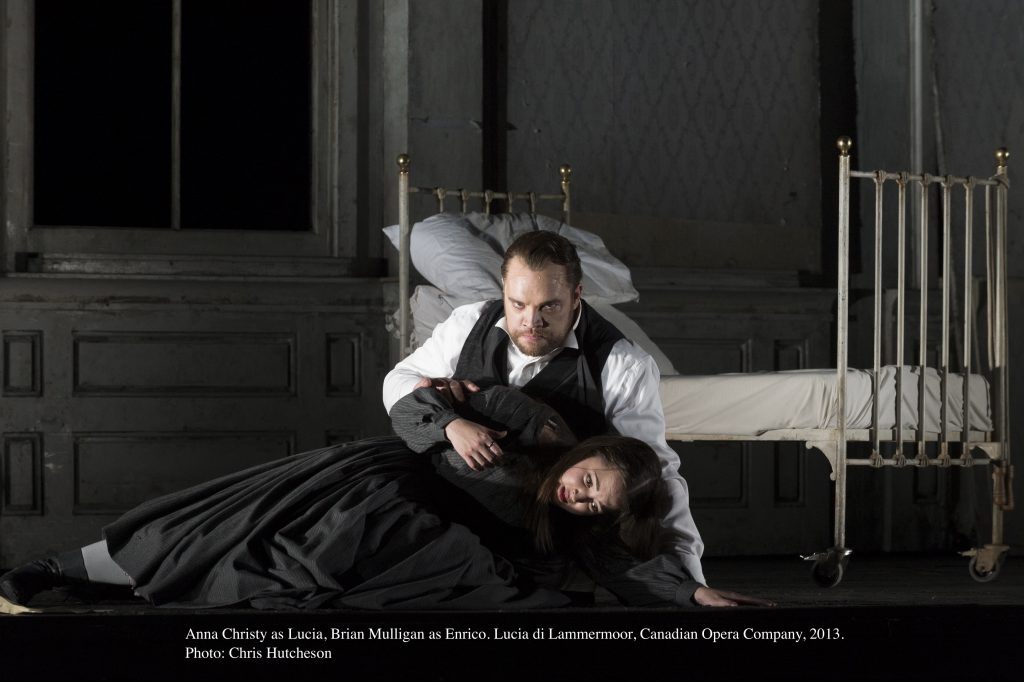As an ambitious young composer in Milan, Gaetano Donizetti seemed to be the perfect living embodiment of la bella figura. Chic, confident, handsome, few of his contemporaries could boast of more success on the European opera stage during the first half of the nineteenth century. Historical tragedy, melodrama, opera buffa, the clever, quick study from Lombardy tried it all. And flourished. In little more than ten years, a succession of artistic and financial hits — Anna Bolena and The Elixir of Love among them — had secured his reputation as the rightful heir to the mighty bel canto throne once occupied by Rossini and Bellini. Who could have guessed the depth of disaster and darkness that lay ahead?
In the early 1840s, at the height of his career, Gaetano Donizetti, the dazzling upstart that had thrilled audiences from Rio to Vienna inexplicably began to lose focus. Work became impossible. Dementia seized control. Death was not to come quickly.
Biographers have long searched for a medical basis underlying Donizetti’s sudden vicious mental deterioration. Clinical evidence is scant. Whatever the cause, Lucia di Lammermoor with its definitive mad scene must surely rank as one of opera’s cruelest historical ironies.
The Canadian Opera Company’s spring 2013 production, framed by graphic depictions of violence and abuse, is a powerfully vivid rendition of the already harrowing tale. Bel canto fireworks aside, Lucia di Lammermoor’s brutal intensity makes it a riveting, singularly unsettling operatic experience. Adapted from Sir Walter Scott’s emblematic 1819 novel, The Bride of Lammermoor, librettist Salvatore Cammarano pared away layers of period romanticism, not to mention a goodly number of minor secondary characters, reducing Scott’s earlier true-life story to bloody flesh and bone. Donizetti, too, was inspired to cut to the heart of the drama.
Prior to Lucia di Lammermoor, the bel canto form, the go-to opera brand of the day, tended to obey rigid vocal formulas. Accompanied recitatives were followed by slow cantabile arias seguing to faster rollicking cabelettas. The template was reapplied, virtually unchanged, time after time as characters came and went on stage. Lucia di Lammermoor shook up the mix. Donizetti’s emotional commitment was so intense, the artistry so urgent and compelling, that notions of musical convention essentially dissolved into irrelevance.
Taken together, libretto and music make Lucia di Lammermoor a landmark opera, potent and visceral as anything written by any composer in any period regardless of style or genre. Without Lucia, there could be no Verdi.
In the COC’s latest staging, director David Alden capitalizes on the work’s psychic rawness, setting his offering within the claustrophobic confines of a moldering Victorian Scottish country house. Everywhere cracked, peeling walls are hung with stiff unsmiling portraits, a ghostly gallery of nameless ancestors staring out from their frames with hollow, accusatory eyes. The age has shifted forward two hundred years from the time of Sir Walter Scott’s gothic tale. And the Highlands are even more spine-chilling than ever.
The clan Ashton of Lammermoor has fallen on hard times. Enrico, head of the family, plans to restore his kinsfolk to wealth and influence by marrying his sister Lucia to Arturo, a prominent Scottish nobleman. But Lucia refuses to bend to her brother’s will. Enrico is counseled to avoid forcing the issue. Lucia is still emotionally fragile after her mother’s recent death. Enrico seethes with anger and frustration. Further adding to his fury is a report that his sister has been paying nightly visits to Edgardo, former master of Ravenswood, seat of a hated rival family. Elsewhere at Lammermoor, Lucia awaits Edgardo’s rendezvous. Alisa, her trusted companion, begs Lucia to end the perilous romance. Lucia will hear none of it. Edgardo arrives, announcing he is soon to set sail on a mission to France. Before he departs, he intends to make peace with Enrico in spite of their mutual loathing, vowing to ask him for Lucia’s hand in marriage. Lucia is horrified. Enrico will surely kill him. Fearful and panicked, she convinces Edgardo to agree to a simple exchange of rings, secret tokens of their mutual faithfulness.
Time passes. Enrico and Normanno, his unscrupulous retainer, have not only intercepted Edgardo’s letters to Lucia from abroad but have concocted a forgery in which Edgardo supposedly confesses his love for another woman. Lucia is devastated. Raimondo, the Ashton’s chaplain at Lammermoor, urges Lucia to preserve the family’s honour by marrying Arturo as her brother wished. A joyless ceremony is held. Lucia, is clearly stunned and confused. Suddenly, Edgardo bursts onto the scene. He and Enrico are about to cross swords when Raimondo warns of God’s judgment on murderers. Edgardo learns of Lucia’s apparent betrayal. Cursing her, he flees, flinging his ring to the ground.
Later that night, Enrico challenges Edgardo to a duel. But there is menacing news afoot. Raimondo has word that Lucia has gone mad and stabbed Arturo to death in their marriage chamber. Lucia enters, bloody and deranged, convinced she is married to Edgardo. Enrico is overcome with remorse. But his mercy comes too late to save his sister. Alone at the agreed dueling place, Edgardo encounters Lucia’s passing funeral procession. Realizing her love has never faltered, Edgardo kills himself. An eerie calm settles over the ghastly events.
Contemporary productions of Lucia di Lammermoor have, understandably, grappled with the issue of psychological credibility. Is Lucia’s hideous act of violence a measure of insanity or more a conscious attempt to claw back a life her oppressors have long denied her? Director Alden seems to answer bloodiness begets blood. Madness is born of reason. His is a hauntingly young Lucia, a child-woman, victimized, unempowered, denied the opportunity to make choices, socially, legally, religiously disenfranchised. Years of relentless abuse at the hands of her manipulative brother, much of it clearly sexual, have left her utterly defenseless. Her emotions are stripped as bare as the battered, semi-derelict interior of Lammermoor Castle itself. We have the distinctly uneasy feeling from her very first appearance in the resonant Act I fountain scene with Alisa that this Lucia’s breaking point has already been reached. When the inevitable mad scene comes as it inevitably must, it is a moment, not of wild histrionics in Alden’s searingly convincing treatment, but of almost quiet self-containment, a kind of horrifically internalized mania. Lucia’s life has played itself out, a final appalling tableau privately presented in Lammermoor’s very own domestic theatre, a strikingly effective feature of designer Charles Edwards sombre set.
As Donizetti’s doomed heroine, American coloratura soprano Anna Christy sings with superb focus and control. Her technique is impeccable, her stylistic choices uniquely illuminating. Bel canto ornamentation is consistently balanced and informed. Refreshingly free of artificially inflated cadenzas, Christy’s singing in Lucia di Lammermoor’s iconic mad scene is a model of vibrant expression. But it is in Miss Christy’s many moments of varied engagement with other members of this production’s exceptional cast that the true range of her virtuosity shines. Her tender Act I duet with Edgardo, “Ah! Verrano a te sull’aure” (“Born by gentle breezes”) is a rare, treasured expression of joy in an opera otherwise utterly given over to the dark side. Miss Christy’s Lucia is beyond heartbreaking.
Fellow American, tenor Stephen Costello brings a splendid Italianate sound to his COC debut as Lucia’s deceived love interest. With his clear, lofty top notes and bottomless well of expression, Mr. Costello presents a show-stopping Edgardo of immensely charismatic proportions. Alone on stage for the opera’s finale, Costello carries the full bitter weight of Donizetti’s classic grand aria, “Fra poco a me ricovero” (“Soon an uncared for tomb”) with great self-assurance. Cheers from the house are well deserved.
In a bravura performance of taxing dimensions, Brian Mulligan unleashes the full measure of his extraordinarily flexible baritone as Lucia’s tyrannical brother. His is a thankless role — malicious, contemptible, sinister. The disquieting growl Mulligan employs at the low end of his voice and the vicious snap at the top gives his performance a hugely menacing quality. This is a savage Enrico, cruel and unpredictable. Mulligan mesmerizes.
Demonstrating an equally skillful command of operatic stage technique, Oren Gradus pushes deep into sonorous bass baritone territory as Raimondo, the collaborator priest. Former COC Ensemble Studio members Sasha Djihanian (Alisa) and Adam Luther (Normanno) powerfully define their characters, singing with both nuance and precision. Tenor Nathaniel Peake is a fine, foppish Arturo.
Conductor Stephen Lord leads the always glorious COC orchestra, tracing Donizetti’s long gorgeous lines of legato with grace and refinement. Tempi are consistently respectful. Harmonies are exquisite. The use of glass harmonica, an eerie nineteenth century Victorian parlour instrument, to underpin Lucia’s mad scene, comes as a welcome surprise. Chorus master Sandra Horst’s exceptional singers do double duty as a crowd of rapacious creditors later reassembling as the Lammermoor wedding party. Both appearances are electrifying.
Lucia di Lammermoor makes big demands on stage and in the auditorium. Originally created for London’s ENO, the transplanted COC presentation currently on view at Toronto’s Four Seasons Centre serves as a reminder that opera is a dangerous art form. Charting this production’s terrifying emotional landscape requires no small amount of courage for any audience. Deep breath. Hold tight. There is no easy route through the darkness.








